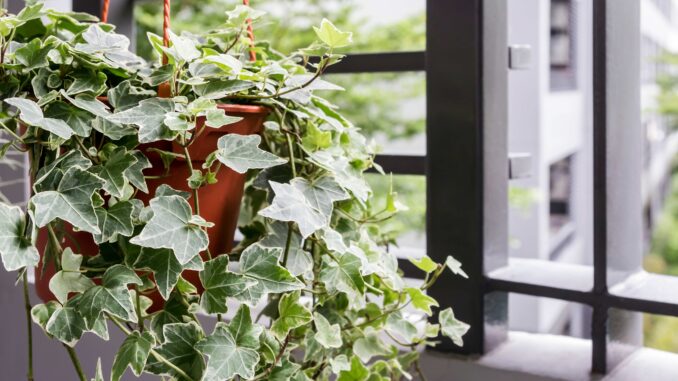
With the warm summer weather upon us, many are ready to spruce their homes up with a little greenery. But be warned, some of the most common houseplants can actually be toxic, not only to humans but to our pets too!
As searches for “plants toxic to dogs” increased by a whopping 300%* over the past three months, London rubbish removal company, Clear It Waste, sought to discover which popular houseplants are the most harmful to us and our furry friends, and further provided guidance on the steps to take if you suspect ingestion of a toxic plant.
10 common summer houseplants that are toxic to you and your pets
Peace Lily – 36,000 monthly searches [High Toxicity]
Having the highest average searches per month, The Peace Lily not only has detoxifying qualities for the home, but it’s also beautiful to look at. Considered one of the most popular flowering houseplants with its dark leaves and low maintenance, it’s a charming spring/summer décor addition to your home. But be warned, it’s toxic to cats and dogs. If consumed, Peace Lily can cause irritation to the throat and mouth.
Snake Plant (Mother-in-Law’s-Tongue) – 32,000 monthly searches [Moderate Toxicity]
This plant is primarily known for its long sword-like leaves and for being a slow-growing plant, making it incredibly low maintenance. Whilst the Snake Plant may be among the top plants named by NASA to be useful for its air-purifying qualities. It is moderately harmful to humans and pets and if swallowed can cause nausea and vomiting.
Calla Lily – 18,000 monthly searches [High Toxicity]
Although this plant is typically cared for outdoors, it’s becoming increasingly fashionable to stylise indoor spaces with. However, like its family counterparts, this lily is harmful to humans, dogs and cats when ingested because of calcium oxalate crystals which can cause swelling and pain when swallowed.
Philodendron – 14,000 monthly searches [Moderate Toxicity]
This spectacular looking house plant originated from the South American rainforests and most certainly deserves its Greek name of ‘loving tree’ thanks to its heart-shaped leaves. But be wary that it’s potentially harmful. If ingested it can cause immediate pain and burning sensations, as well as swelling of the mouth, throat and tongue.
Pathos (Devil’s Ivy) – 12,000 monthly searches [High Toxicity]
Pathos, or Devils Ivy as it’s more commonly referred to, is an extremely popular houseplant because of its attractive drape and ease of care. It’s a great houseplant for kitting your home out on a budget. Like the Peace Lily, it’s safe to touch, but toxic to both cats and dogs when consumed. Ingesting any part of Pathos can lead to diarrhoea, vomiting and in some severe cases, liver failure.
English Ivy – 5,700 monthly searches [Moderate Toxicity]
English Ivy is probably one of the most well-known plants, probably for its pointed leaves and delicate tree-climbing abilities. It is also famous for causing weakness, vomiting, throat swelling, dermatitis, rash, and ataxia, to both humans and animals.
Dieffenbachia – 4,900 monthly searches [Moderate Toxicity]
Dieffenbachia is one of the easiest indoor houseplants to care for. This tropical shrub has beautiful hues of cream, yellow and white making it the perfect plant to brighten your home. But be warned this popular plant contains oxalates which can cause swelling and drooling, if swallowed. As well as irritation, swelling, and redness if it comes into contact with skin or eyes. Dieffenbachia can be dangerous to your cats and dogs, as well as yourself.
Sago Palm – 2,300 monthly searches [High Toxicity]
These houseplants are super fun additions to the home because of their spiky and ancient look. But don’t be fooled, they’re highly toxic when ingested and can cause vomiting, diarrhoea, and in the worst cases, liver failure. Sago Palms are poisonous to humans, dogs and cats.
Caladium (Elephant’s Ear) – 2,100 monthly searches [High Toxicity]
Known for its bright aesthetic colours and velvety to the touch leaves, Elephant’s Ear is great for adding a touch of sass and vibrance to your home. But be cautious when around your cat, dog and children, as it can cause swelling, eye pain, diarrhoea, and vomiting if eaten.
Arrowhead – 1,300 monthly searches [Moderate Toxicity]
Related to the Philodendron plant, the Arrowhead is relatively easy to care for. Bushy in its appearance and with heart-shaped leaves, this plant is mild in toxicity to humans and animals, but can cause skin irritation, an upset stomach and vomiting.
What to do if your pet ingests a poisonous plant:
According to the ASPCA Poison Control, there are thousands of plants that pose a threat to our pets, exhibiting a range of effects on them from mild to life-threatening symptoms. Hence, it’s vital to recognise poisonous plants that may cause harm.
If you suspect your pet has eaten a potentially dangerous plant, it’s best to get in touch with a veterinarian straight away rather than waiting for symptoms to manifest.
If you happen to witness your pet consuming a potentially toxic plant, quickly remove the plant from its mouth and gently rinse the mouth with water. Take immediate note of any symptoms and capture a photograph of the offending plant which can be shown to the vet later on.



